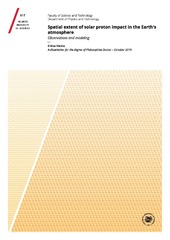| dc.contributor.advisor | Partamies, Noora | |
| dc.contributor.author | Heino, Erkka Petteri | |
| dc.date.accessioned | 2019-12-16T08:59:22Z | |
| dc.date.available | 2019-12-16T08:59:22Z | |
| dc.date.issued | 2019-12-18 | |
| dc.description.abstract | Solar proton events cause large-scale ionization in the Earth's middle atmosphere leading to chemical changes, changes in the energy budget of the middle atmosphere, and radio wave absorption. The accurate implementation of the spatial impact of solar protons and other particle ionization sources in climate models is necessary to understand the role of energetic particle precipitation in natural climate variability. The access of solar energetic particles into the Earth's atmosphere is limited in geomagnetic latitude by the particles' rigidity, the varying conditions of the interplanetary magnetic field and the solar wind, and the distortion of the Earth's magnetic field. The lowest geomagnetic latitude a particle of a given rigidity can access is the cutoff latitude for that rigidity. Proton precipitation in climate models is typically implemented as uniform precipitation poleward of a static latitude limit and cutoff latitudes are not included.
The spatial impact of solar proton events in the Earth's atmosphere is studied in this thesis by comparing the results of a chemistry-climate model to observations of cosmic noise absorption (CNA), testing two cutoff latitude models with CNA observations and modeled CNA, and employing a new approach of using routine background radio noise measurements from ionospheric high frequency radars. A correction method for the nonlinearity of riometers to high levels of CNA is also presented.
Based on the research presented in this thesis, the current proton forcing in climate models significantly overestimates the impact area of solar proton events. The implementation of a cutoff latitude model into the proton forcing is therefore recommended for future studies of solar proton event impact on the atmosphere and natural climate variability. | en_US |
| dc.description.doctoraltype | ph.d. | en_US |
| dc.description.popularabstract | The accurate implementation of the spatial impact of solar proton events and other particle ionization sources in climate models is necessary to understand the role of energetic particle precipitation in natural climate variability. The spatial impact of solar proton events in the Earth's atmosphere is studied in this thesis by comparing the results of a climate model to observations of radio wave absorption, testing two models of proton access to the atmosphere with observations and modeling results, and employing a new method of using ionospheric high frequency radars. Based on the research presented in the thesis, the current solar proton event implementation in climate models significantly overestimates the solar proton impact area. Improving the implementation is recommended for future studies of energetic particle precipitation effect on the atmosphere and natural climate variability. | en_US |
| dc.description.sponsorship | University Centre in Svalbard, Academy of Finland, Research Council of Norway | en_US |
| dc.identifier.isbn | 978-82-8236-378-5 (trykt) 978-82-8236-379-2 (pdf) | |
| dc.identifier.uri | https://hdl.handle.net/10037/16914 | |
| dc.language.iso | eng | en_US |
| dc.publisher | UiT Norges arktiske universitet | en_US |
| dc.publisher | UiT The Arctic University of Norway | en_US |
| dc.relation.haspart | <p>Paper I: Bland, E.C., Heino, E.P., Kosch, M.J. & Partamies, N. (2018). SuperDARN radar-derived HF radio attenuation during the September 2017 solar proton events. <i>Space Weather: The international journal of research and applications 16</i>(10), 1455-1469. Also available in Munin at <a href=https://hdl.handle.net/10037/14662>https://hdl.handle.net/10037/14662</a>.
<p>Paper II: Heino, E., Verronen, P.T., Kero, A., Kalakoski, N. & Partamies, N. (2019). Cosmic noise absorption during solar proton events in WACCM-D and riometer observations. <i>Journal of Geophysical Research: Space Physics, 124</i>(2), 1361–1376. Also available in Munin at <a href=https://hdl.handle.net/10037/16928>https://hdl.handle.net/10037/16928</a>.
<p>Paper III: Heino, E. & Partamies, N. Observational validation of cutoff models as boundaries of solar proton event impact area. (Submitted manuscript). Now published in the <i>Journal of Geophysical Research: Space Physics, 125 (2020)</i>, e2020JA027935, <a href=https://doi.org/10.1029/2020JA027935>https://doi.org/10.1029/2020JA027935</a>. | en_US |
| dc.rights.accessRights | openAccess | en_US |
| dc.rights.holder | Copyright 2019 The Author(s) | |
| dc.rights.uri | https://creativecommons.org/licenses/by-nc-sa/4.0 | en_US |
| dc.rights | Attribution-NonCommercial-ShareAlike 4.0 International (CC BY-NC-SA 4.0) | en_US |
| dc.subject | VDP::Mathematics and natural science: 400::Physics: 430::Space and plasma physics: 437 | en_US |
| dc.subject | VDP::Matematikk og Naturvitenskap: 400::Fysikk: 430::Rom- og plasmafysikk: 437 | en_US |
| dc.title | Spatial extent of solar proton impact in the Earth's atmosphere - Observations and modeling | en_US |
| dc.type | Doctoral thesis | en_US |
| dc.type | Doktorgradsavhandling | en_US |


 English
English norsk
norsk
